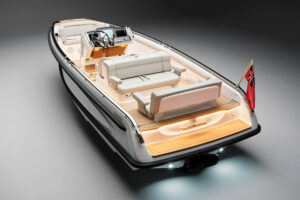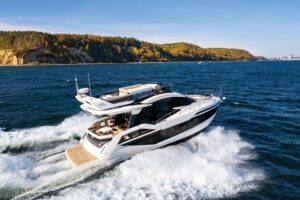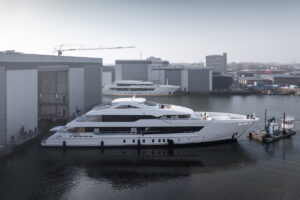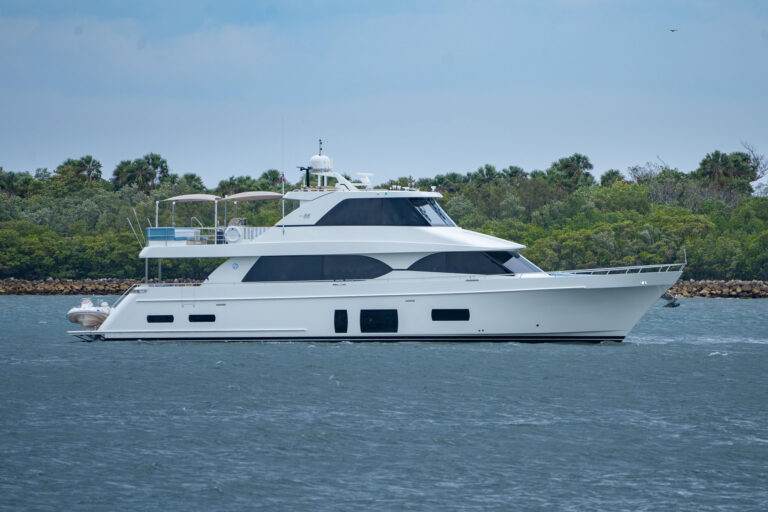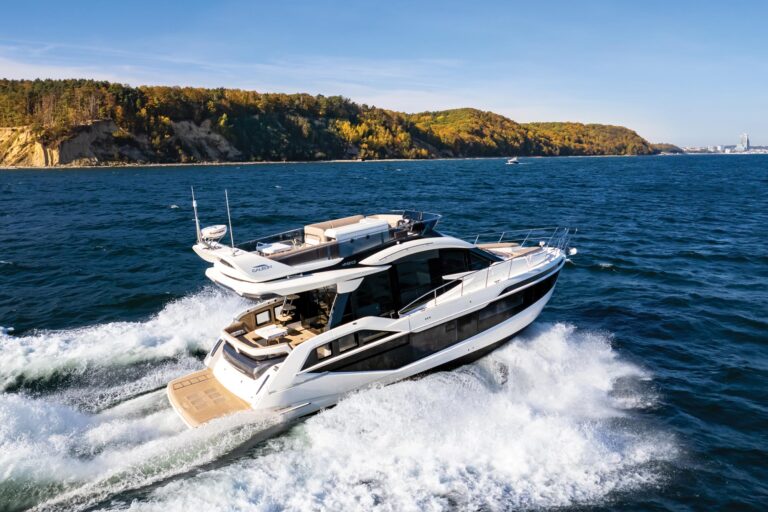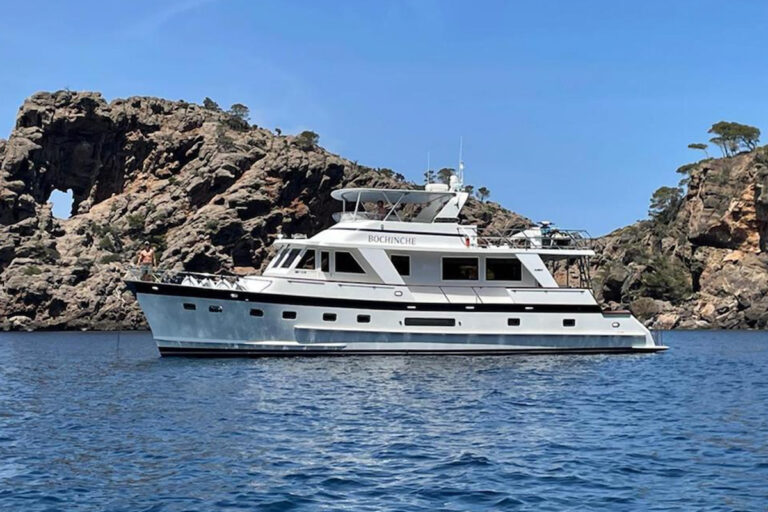It’s been centuries since Spain was a world-conquering naval power although with coasts on both the Atlantic and Mediterranean, it should be no surprise that seafaring traditions continue to run deep. But if you’re picturing a crew of grizzled fishermen guzzling red wine while planking a wooden fishing boat, think again.
Rodman Polyships, which builds the Rodman 565, is an immense and sophisticated shipyard on the cutting edge of technology, from computer analysis and design to exotic composites.
Rodman may be unfamiliar to most Americans but, for the rest of the world, the name is synonymous with boats that are tough, seaworthy, and well built. Founded in the early 1970s, Rodman earned its reputation building composite military and commercial craft. Nations in South America, Europe, Africa and the Orient have Rodman patrol boats in their naval and customs fleets and, with more than 11,000 craft built in less than three decades, Rodman has vast experience.
The Rodman 565, imported to the United States by Rodman USA, draws on that military side. In fact, the hull of the 565 is adapted from that of a water-jet powered 68-knot customs patrol boat.
Step away from the swoopy Euro-styling of the 565 and you’ll see a hull that is designed and built to chase bad guys at high speed in the worst of conditions. The deep-V hull carries the strakes well above the waterline forward, giving the 565 a purposeful look that not only strikes fear in smugglers, but provides a soft ride in nasty seas. The hull sides are carried far forward, which gives the 565 a wide beam at the waterline for form stability and immense inside volume.
Though the hull lineage is from no-nonsense patrol craft, the rest of the 565 is pure Riviera luxury. Step inside the saloon from the teak-planked afterdeck, and your first impression is one of open space, from the soaring waveform of the overhead to the airiness from the large windows. With a cherry finish and intricately inlaid joinery, the saloon is a showcase of craftsmanship.
Although the yacht has comfortably wide walk-around side decks, the 16-foot beam still provides the 565 with ample space for a creamy leather U-shape settee and a built-in loveseat, as well as the usual amenities of television, entertainment center and bar. With no bulkheads to break up the view, guests in the saloon can see forward through the pilothouse windows as easily as aft through the stainless steel sliding doors.
One feature American buyers will find unusual is the galley down arrangement, which lowers this area four steps and puts the chef waist-high to the saloon sole. It’s well equipped with Corian counters, full appliances and good stowage including a spacious under-floor pantry. The benefit is that it not only maximizes the usable saloon area, it allows the cook to remain a part of the conversation. For more traditional tastes, a galley up arrangement is available.
To port is a wrap-around dinette that is likely to be the gathering place while underway. With a table that expands via a hidden leaf, it also doubles as a dining area.
The master stateroom is forward with an en suite head. The shower is a bit on the smallish side for those of who are circumferentially challenged.
What will come as a surprise in a yacht of this size is the VIP stateroom aft off the passageway. With a queen berth and the same padded headboard as the master, it has full headroom courtesy of the two-level sole and the raised pilothouse above. There is a compact vanity with ottoman, hanging and stowage lockers, and an opening port with curtain. Frankly, I’d be tempted to use this as the master stateroom for the cozy feel and the larger berth, but it doesn’t have private access to the head with shower to port. Nevertheless, no guests are going to feel like second-class citizens in this stateroom.
To starboard of the passageway is a third cabin with two singles and both hanging and locker stowage. Like the others, it has good headroom and a spaciousness that reflects the cleverly designed layout.
Perhaps the most impressive feature of this cabin, however, is the direct access to the wiring and systems beneath the helm. Here you see where Rodman has put its vast military experience to use. The wiring is a textbook example, with neatly loomed and labeled wires, full access to electronics panels, and enough elbowroom to delight any service personnel.
Although designed to be easily handled by a couple, there is also a tidy crew cabin tucked under the cockpit aft and accessed through the transom bench seat.
The Rodman has two helm stations. The pilothouse is raised with the helm to starboard, and the skipper has a superb all-around view including both corners of the stern, which is so essential when backing down. There is ample space for flush-mounted electronics.
The flying bridge, reached by interior or exterior stairs, has a centerline helm seat. The bridge is going to seem shallow to those used to the deep bridge coamings surrounding American-styled convertibles, since the rails and the forward dash with venturi are low. But when running the 565 offshore in strong winds, it was apparent that the designers knew their business since only a light breeze reached the cockpit occupants.
A sunpad is aft on the bridge under the electronics arch, since the tender is likely to be stowed on the extra-wide transom platform. A clever feature is the Berenzoni passerelle on the transom that doubles as a hydraulic crane to launch the tender.
Beyond the buttery leather and the glossy cherry is the real Rodman 565, and you’ll see the seaman-like side in the engineroom, where you can move around on diamond-plate flooring to reach everything from seacocks to steering to the outboard sides of the engines. There are even aluminum protectors that cover the prop shafts so you can roam the engineroom safely even when the boat is running.
Our test highlighted that accessibility when a coupler blew off the exhaust system on our zero-hour yacht. With his trusty Leatherman multi-tool, Rodman USA’s Jeff Garcia dove into the engineroom offshore with one engine running and quickly had us up to speed again. On many boats, we would have limped back into port so someone could crawl into an impossible-to-reach space for the repair.
Speaking of speed, the 565 also draws on the performance of her military sisterships, and we easily topped 32 knots with the twin Volvo D12 715hp diesels. Several engine options, including MAN, Caterpillar and Cummins, range from 615- to our 715-hp, and generator options included our Onan 17kW.
We had the ideal test day, with strong winds turning the Gulf Stream off Ft. Lauderdale into the lumpy hard-edged seas that can try lesser boats. But even with steep 4-foot seas running, we had no problem running upwind at 30 knots. The hull threw the spray far to the sides, the wake was flat, and only the occasional gust of wind tossed a mist of spray toward the bridge.
At speed, the helm was fingertip light and turning at 28 knots, even in those seas, was solid and secure as the 565 banked tightly around. Trim tabs are an option but the 565 came onto plane smoothly without appreciable bow rise and, once up to cruising speed, handled the Gulf Stream seas with aplomb.
With a tough patrol boat heritage and a luxuriously appointed interior, there’s no question that the Rodman 565 is likely to reestablish Spain as a seafaring power.
Contact: Rodman USA, (866) 366-4716; www.rodmanusa.com.

